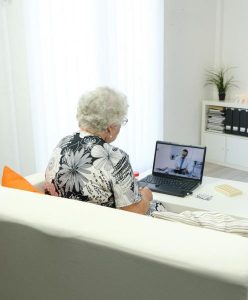
[Reprinted Becker’s Hospital Review, 8-4-2020]
More than one-third of adults aged 65 and older are experiencing challenges seeing providers via telemedicine visits, according to an Aug. 3 study published in JAMA Internal Medicine.
UC San Francisco researchers analyzed data on 4,525 patients from the National Health and Aging Trends 2018 study of Medicare beneficiaries aged 65 or older. Using the data, the research team examined various scenarios that would present difficulties with a video visit, such as poor hearing or eyesight, possible dementia, problems speaking, not owning any Internet-enabled devices, and no use of email, texting or Internet in the last month.
The average patient in the analysis was 79.6 years old, and 69 percent of patients were white, 21 percent were Black and 6 percent were Hispanic. Researchers determined that from overall in 2018, about 38 percent of all older Americans were not ready for video visits, and 72 percent of patients at least 85 years old were not ready, primarily due to inexperience with technology and physical disabilities.
When accounted for having third-party support, 32 percent (10.8 million) of older adults still were not ready for telehealth, and 20 percent (6.7 million) couldn’t participate in a telephone visit due to dementia, difficulty hearing or issues with communicating.
To make telemedicine more accessible, the U.S. needs to implement plans and contingencies geared toward overcoming tech inexperience and disabilities in the older population, said Kenneth Lam, MD, geriatrics clinical fellow at UCSF and lead study author, according to the news release.
“This includes devices with better designed user interfaces to get connected, digital accommodations for hearing and visual impairments, services to train older adults in the use of devices and, for some clinicians, keeping their offices open during the pandemic.”